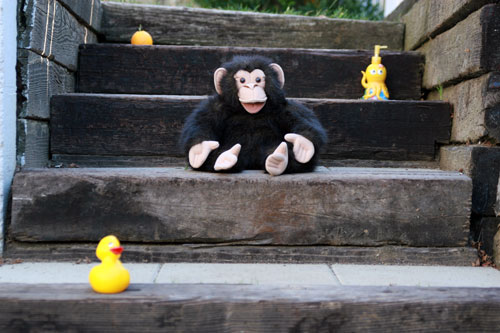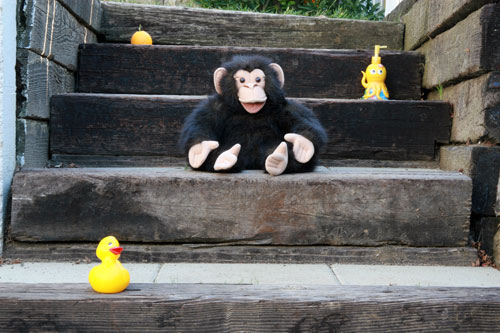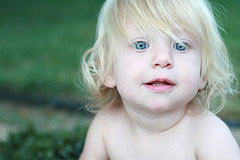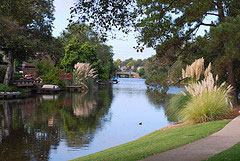
January 31, 2009
Having trouble viewing this newsletter? Read the latest issue online at
https://www.digital-slr-guide.com/dslr-news.html or read back issues
If someone you know has forwarded you this newsletter and you've enjoyed it, subscribe now to receive the next issue when it's published.
DSLR News - January 2009Happy New Year everyone!Welcome to the first issue of the Digital SLR Guide newsletter for 2009. I'd like to kick things off here with a couple of quick summaries:
Let's begin with setting expectations about the future of digital SLR camera technology. By the end of 2008, there were four main features that most manufacturers had added to their cameras: image stabilization, dust control, live view LCDs and enhanced dynamic range. New features that popped up right toward the end of the year included video capture (with the Nikon D90 and Canon EOS 5D Mark II) along with face detection autofocus (the Olympus E-520 and Canon 50D). A brand new type of camera was also introduced by Panasonic - not a true SLR, a micro 4/3rds camera has the size and features of a compact digital camera paired with the ability to change lenses. So what can you expect to see more of in 2009? Definitely more micro 4/3rds cameras from both Panasonic and Olympus, especially ones that also capture video. As for video, look for that feature to be included on many new digital SLR cameras (probably higher end cameras to begin with, but eventually becoming available for the consumer/beginner cameras). As it has done so for years, expect the Canon vs. Nikon battle to continue - but keep a close eye on Sony, who seems determined to make an impression in the digital SLR market, even though they were a very late player to the game. Moving on - what's going to be new at the Digital SLR Guide this year? Well, the biggest news is that I am working hard on a sequel to my current digital SLR lessons. This new set of lessons will cover more advanced camera techniques, and will describe a variety of ways to improve the photos you take with flash. I'm planning to make that available around June. My camera guide poll has indicated that many people want to find out more about the Canon 50D and the Canon Rebel XS - look for guides to both of those over the next couple of months. Otherwise, I'll just keep plugging along to keep you updated on all the latest developments in the world of digital SLR cameras (and will update some pages that sorely need attention). Last but not least - in order to keep the content in this newsletter fresh (and not bore my long-term readers to death) I decided that the newsletter needed a minor upgrade for 2009. There are three main sections that I'll include in each issue: digital SLR camera news (latest developments), basic camera tips (for newcomers) and advanced camera tips (for those with more experience). In short, the newsletter should include a little of something for everyone. Whether you're still looking for the best digital SLR camera, or have one firmly in hand and want to know more about how it works, there should be a section of this newsletter just for you. But enough intro - let's get on with it! |
In This Issue
Latest SLR Guides
Nikon D90
Nikon D60
Canon Rebel XSi
Pentax K20D
Canon 40D
Olympus E-510
Nikon D80
Canon Rebel xTi
Nikon D40
Digital SLR Terms
Megapixels
Stabilization
ISO / Image Noise
Sensor Dust
Crop Factor
RAW vs. JPG
Continuous Photos
Autofocus Points
Aspect Ratio
Lens Terms
Focal Length
Prime vs. Zoom
Maximum Aperture
First vs. Third Party
SLR Lens Features
Canon Lens Glossary
Nikon Lens Glossary
|
New Articles
Coming Soon
- Small Sized Digital SLRs (updated)
- Inexpensive Digital SLRs (updated)
- Top Rated Digital SLRs (updated)
Digital SLR Cameras
This month, I'd like to tackle a fairly tricky question: how long should you wait (if you have been waiting) to buy a new digital SLR?Are the current crop good enough, or is there something right around the bend that will make all the SLRs of 2008 feel obsolete?
I started the Digital SLR Guide in late 2005 and didn't get around to using a variety of cameras until 2006. I can safely say that even back then, digital SLR cameras were quite capable (in the right hands) of capturing extraordinary images.
Early on, the only way the cameras could really differentiate themselves was by their megapixel count, since all other features were pretty much equivalent.
The digital SLR megapixel race was on, but eventually it did reach a plateau: 10 megapixels. Today, 10 megapixel digital SLRs are by far the most common, but by the end of this year that could easily shift to 12 or more.
After the megapixel race settled down, manufacturers had to look for other angles to entice photographers with their cameras.
Olympus came up with two: a dust-cleaning sensor (since dust can contaminate the digital sensor when you change lenses) and a live view LCD. Not surprisingly, both of these useful features are now quite common on all new cameras.
However, buyer beware. If you're considering an older model digital SLR (for the sake of your budget) just be aware that it may not have these more "modern" features.
In addition to dust control and live view, modern digital SLRs have made huge leaps forward in their ability to capture high-quality images in dim light. For a certain type of photographer - one who constantly takes pictures in low light without flash - this alone is a valid reason to buy the latest and greatest.
The issue here is that older digital SLRs produce a LOT more noise at high ISO settings - which means that any setting above 400 is going to create fuzzy-looking photos.
With modern cameras, you can fire away at ISO 6400 and be hard-pressed to see the noise in your images, even when you inspect the photo at full size on a monitor.
But what does the future hold?
Well, if you really want to capture video with your digital SLR then WAIT. Only two cameras currently have a video mode, but if the buzz generated by this feature is any indication it will soon be available on many new cameras.
Articulated LCD screens (ones that flip out from the camera body) might also become more common, since this is SO helpful when using the live view mode.
Speaking of live view, expect to see some real improvements in the performance of live view systems. The current crop of live view LCDs allow you to preview an image before you take it, but autofocus is quite slow, and there's a noticeable delay when taking a photo.
As such, live view is really only good for non-moving subjects - for all others you'll have to use the camera's viewfinder. Expect future versions of live view to perform significantly faster.
To sum up:
- If your budget is tight, then seek out an older digital SLR camera - it probably won't have a dust-cleaning sensor, live view or image stabilization, but it will be a good starting point
- If you have a bit more to spend and want the latest and greatest, then the only limitations of the camera will be lack of video and slow live view performance
- If you'd really like to capture video clips in addition to stills, and want a live view that works more like a compact camera then WAIT to see what 2009 has in store
Beginner Tutorial - Aperture
I'd like to kick off the new year with one of the more confusing components of any digital SLR camera: aperture.Aperture isn't even really a feature of the camera: it's a feature of the lens.
Aperture is a measurement of the opening in the lens. This opening allows light to pass through the lens - that light eventually strikes the digital sensor, which then captures an image.
The aperture of a lens is never completely closed: it is always either narrow or wide open. Furthermore, aperture is a variable setting that can be adjusted by the photographer.
Back in the good old days of manual film SLR cameras, aperture was always set by turning a ring on the lens (right where it attached to the camera). Today, this mechanical system has been replaced with an electronic one.
Many modern digital SLR lenses no longer include an aperture ring. This is because with a digital SLR, you set the aperture using the camera body: electronic contacts allow the camera to communicate with the lens so when you select an aperture on the camera, it adjusts the lens aperture accordingly.
If you do happen to have an older film lens that is compatible with your digital SLR, you will have to lock the aperture ring on the lens (this is often done by turning the ring to the narrowest lens aperture). Once the aperture ring is locked, then the camera will be able to communicate properly with the lens.
Now for the fun part: the aperture numbers themselves.
Part of the fun is that in order for them to make sense, you have to think of aperture numbers as fractions, even though they aren't displayed that way.
Here's why: the larger the aperture number, the smaller the opening in the lens.
Aperture numbers follow a pretty typical scale, and you can always tell when an aperture number is being referenced because it starts with "f/". The aperture scale goes something like this:
f/2.8, f/3.5, f/4.0, f/5.6, f/8, f/11, f/16, f/22
From left to right, the opening in the lens is getting progressively smaller. An aperture of f/2.8 means the lens is wide open, while at f/22 it is quite narrow.
This is why thinking about apertures as fractional numbers might help (unless you're really bad with fractions). For example, if you compared the fractions 1/4 and 1/22, 1/4 is the larger of the two and therefor represents a larger opening of the lens.
This is enough aperture numerology for one month. Next month I'll tackle the issue of stops of light, and will describe how the standard aperture scale can be broken down further.
LESSONS: Get the Most From Your Digital SLR Camera
- Master the controls of any digital SLR
- Dramatically improve the photos you take
- Learn at your own pace
- Download each lesson as a PDF
- Ask me questions
Intermediate Tutorial - Depth of Field
For all you folks who've been reading these newsletters for some time now - this section is for you!My sincere hope is that by now you're well past the point where you need me to explain things like aperture, shutter speed, ISO and white balance (but if you need a refresher then just read the section above).
The tutorials that appear in this section of the newsletter will take the topic that I describe in the Beginner Tutorial and will flush it out further with details for more advanced photographers.
To kick it off, I'd like to talk about the impact that the aperture setting can have on your images: it allows you to control the depth of field.
Unlike your eyes, which are always pretty much focused on everything from the immediate foreground to the distant background, digital SLR cameras have selective focus: they're only able to maintain focus in one area at a time.
Since this area of focus extends all the way across the image, it's also known as the plane of focus. Think of the plane of focus as an invisible wall somewhere in the distance that your camera has decided to focus on.
Everything within the plane of focus will appear nice and sharp.
However, subjects that are either IN FRONT OF or BEHIND the plane of focus will not necessarily also be in focus - this is due to depth of field.
- When you have shallow depth of field, only subjects that are very close to the plane of focus will appear sharp
- When you have deep depth of field, even subjects well in front of and well behind the plane of focus will be sharp
There are three different variables that affect the amount of depth of field that is apparent in your photos:
- Lens aperture
- Lens focal length
- Distance from subject
I'll tackle the impact of focal length and distance from subject in the next newsletter - for this one, we're only going to focus on how lens aperture affects depth of field.
Let's work through an example. In both of the shots that follow, the ONLY variable changing is the aperture of the lens. The focal length of the lens is a constant (70mm) and the distance from the subject is also a constant (about 5 feet or 1.5 meters).
EXAMPLE 1: Wide Open Aperture (f/3.5)

EXAMPLE 2: Narrow Aperture (f/22)

In both images, the plane of focus is set on the stuffed monkey (one of the few subjects in my house that isn't in constant motion).
In the first image, notice how objects in front of the plane of focus (the duck) and behind it (the soap dispenser and orange) don't appear in focus. This is due to the shallow depth of field at aperture f/3.5.
In the second image, everything from foreground to background is sharp, thanks to deep depth of field at aperture f/22.
Here's the relationship:
- OPEN Aperture ==> SHALLOW Depth of Field
- NARROW Aperture ==> DEEP Depth of Field
Apertures in between these two extremes will yield less depth of field the more open the lens aperture and greater depth of field the narrower the lens aperture.
But why does it matter that aperture controls depth of field?
Glad you asked - every camera control has a real-world use, otherwise it wouldn't make sense for manufacturers to keep churning out cameras with all these features included.
Now that you know that the lens aperture can be used to control depth of field, you can apply this creatively in your images to either give every part of the image equal weight or to single out a specific item as the focal point.
Imagine that you're snapping an image of a beautiful flower in the countryside. You have two ways to take this picture (assuming that the plane of focus in both is set to the flower):
- Use a wide aperture to blur both foreground and background, causing the flower to stand out
- Use a narrow aperture to keep the entire landscape clear from immediate foreground to far-off background
The most common use of wide aperture/shallow depth of field is for portrait work since you don't want either foreground or background to compete with your portrait subject. Narrow aperture/deep depth of field is often used for landscape photography, where you want everything in the image sharp for maximum impact.
 |
 |
|
| Shallow Depth of Field | Deep Depth of Field |
Be careful though!
There are two important considerations to bear in mind as you apply shallow depth of field to portraits and deep depth of field to landscapes:
- Don't go too shallow for portraits - it's possible with portrait photos to use an aperture that's too wide: this results in a subject who's nose is nice and clear but who's eyes are out of focus (not good)
- Watch shutter speed for landscapes - when you use very narrow apertures, the shutter must be kept open for a longer period of time to capture a correct exposure. If your shutter speed gets too slow, your entire photo can be blurry, negating any blurriness caused by shallow depth of field. This is why many landscape photographers use tripods to ensure that their cameras are perfectly steady even when using very narrow lens apertures.
Photo Links
Other Photography Sites
- Betterphoto.com - a wealth of photography learning opportunities
- Photojojo - tons of photography do-it-yourself (DIY) projects
- Flickr - share your photos with friends and others
- Strobist - everything you ever wanted to know about lighting with external flash
- Photo.net - plenty of learning resources and examples of exceptional photography
Recommended Digital SLR Retailers
(These are the three online stores that I use to purchase all of my digital SLR photography gear)In Conclusion
I have caught one cold after the other in the month of January, but finally seem to be on the mend.At least I was able to work on this newsletter at different intervals when I actually felt well enough to do so.
I hope that you're reading this newsletter in good health, and that you are able to get outside with your digital SLR camera and experiment a bit with some of the information that you've learned from this newsletter.
Next month, we'll get into more detail about aperture and I'll provide some more information about the digital SLR camera models that are rumored for 2009.
Until then, happy picture-taking!
--Chris Roberts, Your Digital SLR Guide